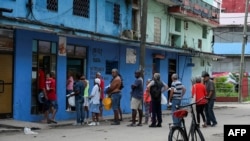Rafael strengthened Wednesday into a powerful Category 3 hurricane ahead of its expected landfall in western Cuba, where it was forecast to bring “life-threatening” storm surges, winds and flash floods.
The storm, which knocked out power and dumped rain on the Cayman Islands and Jamaica, is expected to hit the Isle of Youth in the coming hours and make landfall later on Wednesday.
Classes and public transport were suspended on parts of the island as authorities issued an alarm for the incoming weather for the west of the country. Workers secured buildings and cleaned up garbage along Havana’s coastline in preparation for floods. Authorities also canceled flights in certain areas like Havana and Varadero. Thousands of people in the west of the island were evacuated as a prevention measure.
“Preparations to protect life and property should be rushed to completion,” warned the National Hurricane Center in Miami.
The storm was located about 65 kilometers (40 miles) east-southeast of the Isle of Youth and around 135 kilometers (84 miles) south-southeast of Havana. It had maximum sustained winds of 185 kph (115 mph) and was moving northwest at 22 kph (14 mph), according to the National Hurricane Center in Miami.
Forecasters expected the storm to later weaken over Cuba, but emerge in the southeastern Gulf of Mexico as a hurricane.
Cubans have already been struggling with blackouts while recovering from another hurricane two weeks ago that killed at least six people in the eastern part of the island.
The U.S. State Department issued an advisory for Cuba on Tuesday afternoon, offering departure flights to non-essential staff and American citizens, and advising others to “reconsider travel to Cuba due to the potential impact of Tropical Storm Rafael.”
On Tuesday morning, the Cuban Civil Defense called on Cubans to prepare as soon as possible, because when the storm makes landfall “it’s important to stay where you are.”
Silvia Perez, a 72-year-old retiree living in a coastal area of Havana, was among those scrambling to prepare. As other neighbors moved appliances and other furniture from ground floor homes, worried about floods, Perez stocked up on water and food.
“This is a night I don’t want to sleep through, between the battering air and the trees,” Perez said. “I’m scared for my friends and family.”
A hurricane warning was in effect on Wednesday for a portion of the Cayman Islands and the Cuban provinces of Pinar del Rio, Artemisa, La Habana, Mayabeque, Matanzas and the Isle of Youth.
A tropical storm warning was in effect for the Cuban provinces of Villa Clara, Cienfuegos, Sancti Spiritus and Ciego de Avila, as well as the lower and middle Florida Keys from Key West to west of the Channel 5 Bridge, and Dry Tortugas.
The storm on Tuesday knocked out power in parts of Jamaica and unleashed flooding and landslides. The Jamaica Public Service, the island’s electricity provider, said in a statement late Tuesday that impassable roads were preventing crews from restoring power in some areas.
Power outages were reported across the Cayman Islands after a direct hit late Tuesday, and schools remained closed on Wednesday.
“While conditions have improved on Grand Cayman, residents are advised to exercise extreme caution on the roads and near coastlines as rough seas and residual flooding risks may persist,” the government said in a statement.
Heavy rainfall also was expected to spread north into Florida and nearby areas of the southeast U.S. during the middle to late part of the week. The Hurricane Center predicted storm surges in Florida could reach 1 to 3 feet in Dry Tortugas and 1 to 2 feet in the Lower Florida Keys. A few tornadoes also were expected Wednesday over the Keys and southwestern Florida.
Rafael is the 17th named storm of the season.
The National Oceanic and Atmospheric Administration predicted the 2024 hurricane season was likely to be well above average, with between 17 and 25 named storms. The forecast called for as many as 13 hurricanes and four major hurricanes.
An average Atlantic hurricane season produces 14 named storms, seven of them hurricanes and three major hurricanes.



